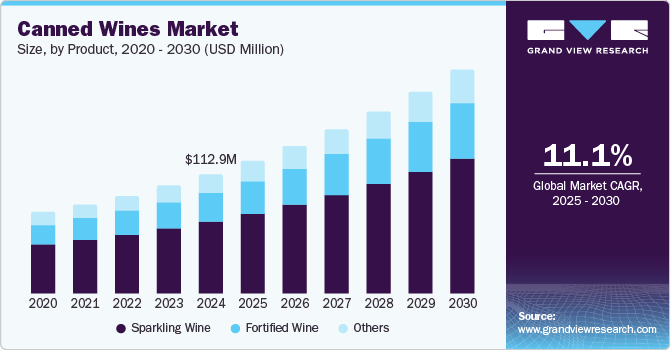The global canned wines market was valued at USD 112.9 million in 2024 and is expected to grow at a compound annual growth rate (CAGR) of 11.1% from 2025 to 2030. The rising preference for portable, convenient, and single-serve beverage options—particularly among younger demographics—is one of the key drivers of market expansion. Additionally, the growing appeal of ready-to-drink (RTD) products, driven by fast-paced lifestyles and demanding work schedules, has significantly fueled demand in both developed and emerging economies. Activities such as weekend getaways, camping, and hiking are gaining popularity, further boosting sales of canned beverages, which offer ease of use and eliminate concerns like spillage or breakage associated with traditional bottles.
The shift toward health-conscious living, particularly in advanced markets such as the U.S. and Western Europe, has created strong growth prospects for the canned wines sector. Many canned wine products are crafted in lighter, lower-alcohol formats that align with wellness-oriented consumer habits. Shoppers increasingly seek beverages that support healthier living—those with fewer calories, minimal additives, and lower alcohol levels. The single-serve format of canned wines also allows for better control over alcohol intake, resonating with the trend toward mindful consumption. Furthermore, these products are typically more cost-effective than bottled wines due to their lower production and packaging expenses, making them especially appealing for casual consumption and budget-friendly occasions.
Environmental sustainability continues to be a key factor influencing consumer choices and driving market growth. Canned wines are often considered more environmentally friendly than their bottled counterparts, primarily due to the recyclability of aluminum cans. As awareness around plastic and glass waste grows, more consumers are gravitating toward products with reduced environmental impact. Aluminum cans are also lighter and more space-efficient, cutting down transportation emissions and overall carbon footprint—further supporting the shift toward eco-friendly alternatives.
The canned wine category has experienced a surge in innovation, with brands introducing a variety of product types including sparkling wines, wine spritzers, and unique blends. These innovations appeal to a broader audience by offering diverse flavor experiences in a user-friendly format. Trend-forward offerings like sangria, flavored wines, and wine-based cocktails are drawing in both new wine consumers and those looking for a more relaxed, casual option.
Get a preview of the latest developments in the Global Canned Wines Market! Download your FREE sample PDF today and explore key data and trends
Regional Insights
North America led the global canned wines market in 2024, accounting for 37.7% of total revenue. This dominance is largely attributed to rising wine consumption in the region and the widespread availability of canned wine options. Among younger and middle-income consumers in the U.S. and Canada, canned wines are seen as a cost-effective and accessible alternative to bottled wines. Their appeal lies in affordability, ease of use, and a trendy image that resonates with Millennial and Gen Z consumers. These younger demographics are particularly drawn to the convenience and sustainability that canned wines represent.
Key Players in the Canned Wines Market
The following companies hold significant market shares and are instrumental in shaping industry trends:
- E. & J. Gallo Winery
- Union Wine Company
- Sans Wine Co.
- Sula Vineyards Limited
- SUNTORY HOLDINGS LIMITED
- Canned Wine Co.
- Maker Wine Company
- Archer Roose Wines
Gather more insights about the market drivers, restrains and growth of the Canned Wines Market
